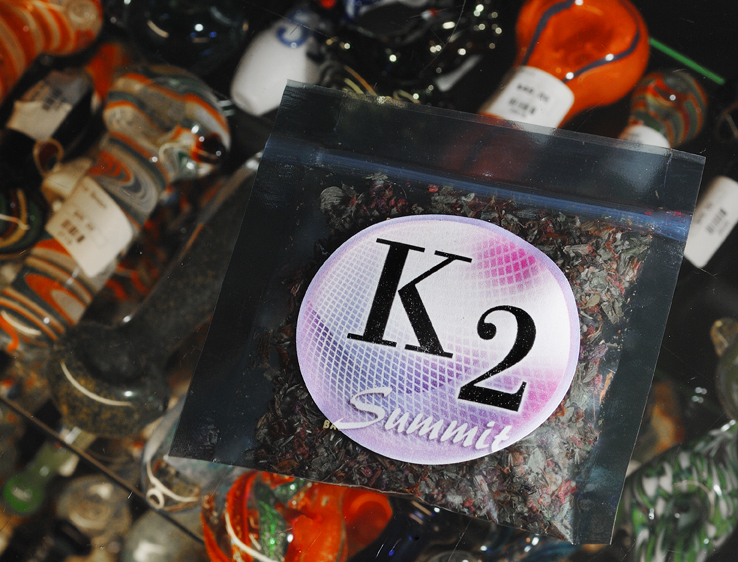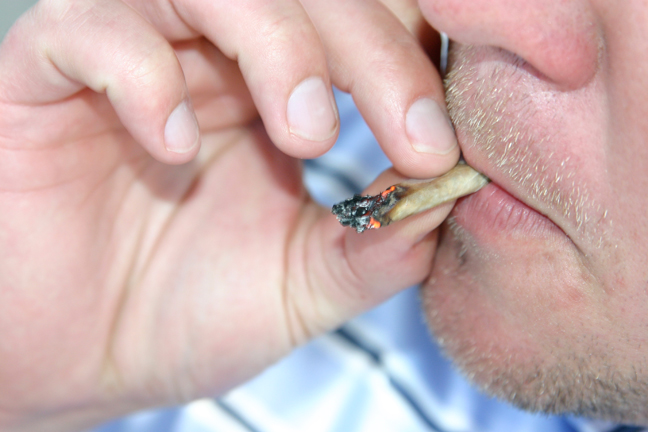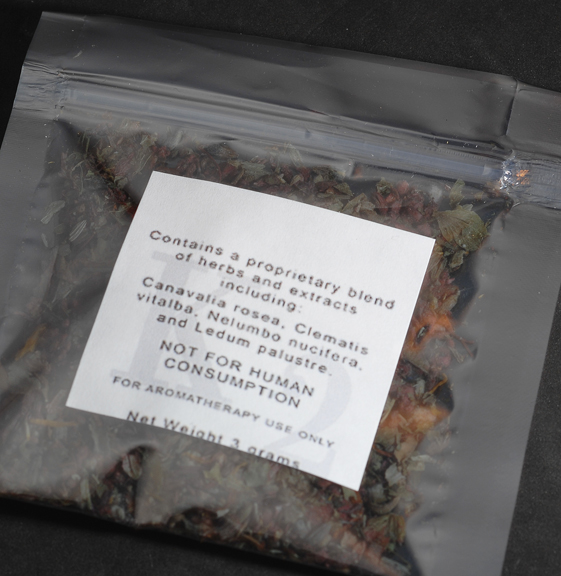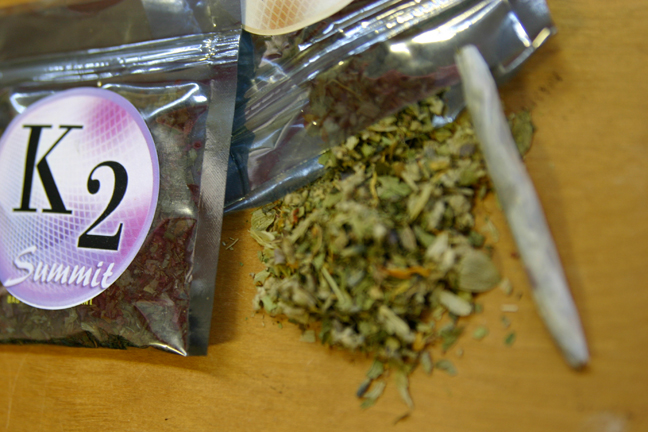It’s 3:40 p.m., and Paschal High School is letting out. The kids scatter, heading home to study or play sports or chill out. But some of the school’s brightest and most promising students make a shorter trip. They cross East Berry Street to the local head shop to pick up three grams of its most popular product.
 The shop, Fusion, has the usual glass cases full of pipes and papers, ashtrays, and candles. Black lights bounce off the posters and t-shirts for sale.
The shop, Fusion, has the usual glass cases full of pipes and papers, ashtrays, and candles. Black lights bounce off the posters and t-shirts for sale.
Most of the young after-school smokers head home with their purchases, but others relax on the back room’s black couches, getting high in the hazy comfort of the hookah lounge.
The stuff that’s flying off the shelves of head shops all over the country goes by brand names like K2, Spice Gold, and Hawaiian Haze, and it’s replacing marijuana in the lives of student athletes, police officers, and stoners who just don’t want to get caught breaking the law. What they’re smoking is billed as an herbal incense, but the herbs in this case have been sprayed with one or more compounds that are the synthetic equivalent of THC — the compound in marijuana that gets you high.
The three-gram packages go for $40 to $50 and are marked as being “not for human consumption.” But that’s just another one of those lies that are the basis of head shops: The bongs are just decorative objects, the papers are for rolling tobacco cigarettes — and K2 is not for smoking. The shop owner, Walt (he didn’t want his last name used), said that the use of K2 going on at his business doesn’t violate the “no-consumption” admonition because it is being “vaporized” and not smoked. Technically, he may be right, but the distinction doesn’t mean much to most K2 fans.
“K2 is the most phenomenal thing that has ever happened to this business,” Walt said. “Even though it just started getting popular in the last month of 2009, it is definitely the best product of the decade.”
If the profits are fantastic for the people who sell K2, the news isn’t necessarily all that great for the buyers. It can cost up to twice as much as low-grade marijuana, and most users say its high lasts an hour at most. The quality of the buzz that it provides can also be uneven. But the irony is that while brands like K2 are providing — for now — a legal way for folks to get high, it could be more dangerous to their health than smoking marijuana. It’s enough to harsh the buzz of any K2 smoker.
 As with street drugs, it’s almost impossible for buyers to tell just what compounds are in K2. And regardless of which synthetic cocktail has been sprayed on the “incense,” the effects have not been studied in humans.
As with street drugs, it’s almost impossible for buyers to tell just what compounds are in K2. And regardless of which synthetic cocktail has been sprayed on the “incense,” the effects have not been studied in humans.
A national debate has begun over whether the hopped-up herbs are dangerous. Some states — and nine European countries — have already banned the stuff. The U.S. military has forbidden servicemen and servicewomen from using the compounds.
That debate has had some interesting side effects of its own — detractors of the chemically enhanced herbs say the dangers of the unnatural stuff are another argument for why good ol’ marijuana itself should be legalized.
“We simply don’t know what the health effects might be,” Clemson University Professor John W. Huffman said last week about the synthetic compounds. He should know. He’s one of the guys who helped invent the products that others are now selling as the latest thing in the science of getting high.
Anthony, 20, is a Fort Worth restaurant worker who is on probation for an aggravated robbery he committed at a fast-food restaurant while he was in high school. He served 23 months in jail and got out last year. He didn’t want his last name used.
As part of his probation, he must undergo twice-monthly drug tests. He will be on probation until 2018, and he figured he would never get high again. That was until about three weeks ago, when he started smoking K2.
“I had heard about it from some friends, and because it is legal, I had no problem trying it,” Anthony said. “It is not as strong as real pot, but I think it is more mental than physical, like pot can be. It doesn’t last as long, but I do like to do it before work, because it gives me so much more energy.”
Walt, the head shop owner, said he’s selling more than $500 a day of the synthetic-sprayed herbs. And he is surprised by who buys the stuff. “We have a lot of police officers, military personnel, probation officers, folks who might be subject to drug tests,” he said. “We are … starting to have some parents coming in to see what their kids are smoking,” he said. “And what is interesting is they come back for more because they like it.”
Scientists say the psychoactive powers of the synthetic weed are four to five times greater than marijuana. But the people interviewed for this story who are regular users of this fake pot disagree — as did the Weekly’s test panel (see sidebar at right). They said the high is much shorter and not as strong as with regular weed.
 “It hits you immediately but only lasts 45 minutes to an hour at most,” said one Paschal High senior. “After your high ends, however, you feel 100 percent back to normal,” she said, “unlike with weed where your high will go away but you don’t feel sober for the rest of the day.”
“It hits you immediately but only lasts 45 minutes to an hour at most,” said one Paschal High senior. “After your high ends, however, you feel 100 percent back to normal,” she said, “unlike with weed where your high will go away but you don’t feel sober for the rest of the day.”
Another senior said he felt “less paranoid on K2 than I am on weed. I feel more in control of myself when I’m on K2. I also think more clearly, because weed makes me go off on mental tangents.”
A third classmate said K2 and weed provide “different kinds of high. After I come down off the high with weed, I feel tired and lazy. In contrast, when I come off the high of K2, I feel really productive and get things done. I drive better on K2. I get the munchies, though, after smoking both.”
The idea of high school kids debating whether they are more efficient drivers while high on marijuana or K2 makes parents and cops blanch, of course — especially since, in the case of K2, there is no real scientific evidence of its effects on people.
“These THC synthetic compounds affect movement and perception and the ability to react. But again, this has moved up on us so quickly that we really don’t know what effects it will have on people,” said Marilyn Huestis, a chemist for the National Institute on Drug Abuse.
The synthetic chemicals used in the fake-weed mixtures were originally developed by medical researchers looking for new pain medications. The herbal mixtures first surfaced in Europe around 2006, according to news reports.
 Huffman, at Clemson, is one of the leading researchers in the field. For decades, he worked to develop synthetic cannabinoids, chemicals that would bind to specific brain receptors much as THC does and possibly help alleviate pain. One of the synthetics he developed in 1994 was named JWH-018; it’s now one of the most popular compounds used in the fake pot. But the synthetic THC compounds have been tested only on animals.
Huffman, at Clemson, is one of the leading researchers in the field. For decades, he worked to develop synthetic cannabinoids, chemicals that would bind to specific brain receptors much as THC does and possibly help alleviate pain. One of the synthetics he developed in 1994 was named JWH-018; it’s now one of the most popular compounds used in the fake pot. But the synthetic THC compounds have been tested only on animals.
“Evidently, some people have figured out how to make them [the synthetic compounds] and are putting them in products marketed as incense,” said Huffman, 77, who has won the National Institutes of Health’s Senior Scientist Award. In a statement released last week by Clemson, in response to a barrage of news media questions, Huffman said that the synthetic cannabinoids “could very well have toxic effects” in humans. … I would emphasize the risk people are taking when they smoke these products.”
There are now more than 100 versions of the fake-THC compounds out there, and the fact that they are used in many different combinations makes the untested nature of the substances even chancier. German researchers who tested seven incense products found five different compounds in varying combinations and with widely varying levels of the psychoactive ingredients.
Huestis said the issue of legal fake pot appeared on her radar screen about a year ago. “There are a lot of issues here, but the major one is that no one using this stuff knows what they are getting,” she said. “Some [products] are very powerful, some have very little of the drug in them.”
She said that studies on the synthetic cannabinoids could take a long time. First they would be tested in animals, then in different human groups. After that, scientists would make recommendations on whether some of the compounds should be made subject to the Controlled Substances Act.
“But this will be very difficult to do,” Huestis said. “Right now most labs cannot even identify these compounds. And testing more than 100 of these chemicals will take time and be very costly. And the people who are making these compounds might just change it by adding or removing one atom.”
In Delaware last week, police and paramedics were called to a house where they found two young men and a young woman in severe physical distress after smoking the fake pot. They were suffering from breathing troubles, heart palpitations, and projectile vomiting. They were taken to the emergency room.
![Burnam: “I am appalled that high school kids in my district and across the state are using [products like K2].” Robert Hart feat_4](https://www.fwweekly.com/wp-content/images/stories/images/3-24-2010/feat_4.jpg) Just a few weeks ago an Oklahoma teenager developed similar symptoms at his high school after smoking the incense off campus.
Just a few weeks ago an Oklahoma teenager developed similar symptoms at his high school after smoking the incense off campus.
Dr. Anthony Scalzo, a professor of toxicology at Saint Louis University, said he has seen nearly 30 cases involving teenagers who were experiencing hallucinations, elevated heart rate and blood pressure, and vomiting after smoking the fake weed.
“These toxic chemicals are neither natural nor safe,” Scalzo said.
Because the K2 craze has spread so fast, people who have concerns about it are having to learn fast. John Haenes, who works as a substance abuse counselor for Tarrant County Challenge Inc., a private nonprofit that coordinates substance abuse programs and education, said parents are largely unaware of their children’s use of fake pot.
“We need to educate them as much as possible, because any drug these kids take can have large negative effects,” he said.
Debbie Meripolski, executive director of the Dallas Council of Alcohol and Drug Abuse, met with law enforcement officials and substance abuse counselors last week to talk about the fake weed. “A lot of the people in our meeting were quite surprised about what is happening now,” she said, even though they deal with youth substance-abuse problems on a daily basis.
The DEA is looking closely at the issue. “Synthetic and designer drugs are definitely on the DEA’s radar, as we are seeing several indications that these THC-like substances could be a significant problem both domestically and internationally,” said DEA spokeswoman Dawn Dearden.
 Authorities aren’t sure who is producing the fake weed or where, though most news reports mention China as a leading candidate. Dozens of distributors in this country advertise the compounds on their own web sites, and through publications like Fort Worth Weekly. One company web site said the particular compound it offers “is only sold as a fertilizer and for research.” Calls and e-mails to several of the companies — Innovative Products, EARTH Fantastick, and Extraordinary Transformation — were not returned.
Authorities aren’t sure who is producing the fake weed or where, though most news reports mention China as a leading candidate. Dozens of distributors in this country advertise the compounds on their own web sites, and through publications like Fort Worth Weekly. One company web site said the particular compound it offers “is only sold as a fertilizer and for research.” Calls and e-mails to several of the companies — Innovative Products, EARTH Fantastick, and Extraordinary Transformation — were not returned.
Because the THC-like compounds are considered untested drugs, the U.S. Food and Drug Administration has banned them from being imported. But the purveyors of K2 are staying ahead of the feds: Fusion now stocks a product produced in the U.S. and distributed by a company in Dallas — and that therefore isn’t affected by import questions.
State Rep. Lon Burnam is one of those who believes that the illegality of pot is forcing young people into using a potentially more toxic drug. “What little I know about this stuff is very scary,” the Fort Worth Democrat said. “I am appalled that high school kids in my district and across the state are using it. People are always going to get high with something or other, but we are driving kids to the unknown, which might be very dangerous.
“This broad use of K2 is just one more reason to legalize marijuana in some ways,” Burnam said. “Because with K2, we don’t know what the side effects are. With marijuana we do.”
Drug foes don’t buy that argument. “Just because kids are dabbling with this new drug doesn’t mean we should legalize marijuana,” said Calvina Fay, executive director of the Drug Free America Foundation. “The fact is, marijuana is harmful. It has a link with some forms of mental illness. Legalizing it would be a horrible mistake. What we need to do is study these synthetic THC drugs and see if they should be made illegal as well.”
Paul Armentano, deputy director of the National Organization for the Reform of Marijuana Laws, said that he’s never seen K2 in head shops in his state of California and doesn’t know anyone who uses it. He believes that is because marijuana possession has been largely decriminalized there.
“Making marijuana illegal has the effect of pushing this market to an unknown drug [for which] we don’t know the risks,” he said.
“We’re in a tough position because it is legal, and law enforcement is not involved,” Meripolski said. “But we have to do something, because this is a mind- altering drug that affects everything from driving to social disorders to just doing their school work well. We have to address this issue with education. But maybe the state might need to step in and ban it.”
Kansas and Missouri have already banned it, and bills to do the same are pending in Illinois and Georgia. Could Texas join that group? “I expect this will be a big issue when the legislature convenes next January,” Burnam said.












Haha dope
Just desire to say your article is as astonishing. The clearness in your post is simply great and i could assume you’re an expert on this subject.
Fine with your permission let me to grab your
feed to keep updated with forthcoming post. Thanks a million and please continue the gratifying work.
It’s a shame you don’t have a donate button! I’d without a doubt donate to this outstanding blog!
I suppose for now i’ll settle for book-marking and adding
your RSS feed to my Google account. I look forward to brand new updates
and will share this website with my Facebook group. Talk soon!
wonderful publish, very informative. I’m wondering why the opposite specialists of this sector do not realize this.
You must proceed your writing. I am sure, you have a huge readers’ base already!